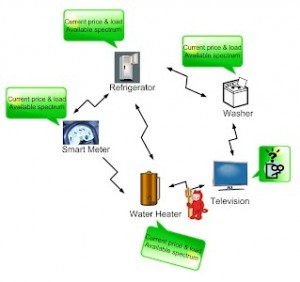Overview
| Led by Professor Yih-Chun Hu, the ReCognize Project (short for Reliable Cognitive radio networks) is a project under the Smart Grid Subprogram at the Advanced Digital Sciences Center (ADSC). The ReCognize project seeks to mitigate the current spectrum shortage by designing an enabling communication platform that is reliable in face of faulty communication devices. | ||
Motivation and ObjectivesIn the past decade, wireless networks have become widely deployed for mobile computing due to their low cost and the convenience they offer users. However, the few ISM (Industrial-Scientific-Medical) bands are heavily occupied in urban areas; numerous users are now experiencing a spectrum shortage manifesting itself as decreasing data throughput. Observing that many frequency bands are underutilized, the research community has proposed the concept of cognitive radio, a radio that can both quickly occupy a vacant frequency band and quickly return the frequency band when the owner returns. Several cognitive radios can form a network in order to share their capabilities in computation, sensing, communication, etc. However, the current designs of cognitive radio networks rely heavily on benign and cooperative radios. Any radios suffering from faults or compromised by malicious adversaries can easily render the entire network unusable. Thus, the main theme of ReCognize is to design reliable cognitive radio networks: |
||
Application to the ADSC Smart Grid SubprogramThe smart grid subprogram at ADSC seeks to push intelligence to the edge of the smart grid network, so that each and every home appliance can benefit from the fast information flow within the network. We call an edge network consisting these home appliances a home area network (HAN). Wireless technology enables any new smart appliance to seamlessly integrate into an existing HAN; however, in a dense-urban area, there might not be enough free spectrum set aside for tomorrow’s HANs. Moreover, consumer electronics may fail with potentially unpredictable misbehaviors; e.g. an electronic equipped with a transmitter might emit random noise-like signals that impacts the HAN similar to malicious jamming.Thus, the local, ad hoc, and fault-prone nature of smart grid HANs present an exciting opportunity to apply the concept of reliable cognitive radio networks: ReCognize can be viewed of as a functional block that helps provide smart grid security at the lowest communication layer. |
 |
|
Results and Ongoing EffortsThe ReCognize project has proposed several protocols that are essential in building a reliable cognitive radio network. Spectrum sensing is an essential primitive of cognitive radio, and we are the first to propose a survey-tampering-resilient individual spectrum sensing technique, as well as a cooperative sensing technique that mitigates the false-reporting-Sybil-attack. We have also proposed a flooding protocol that enables a dense cognitive radio network to distribute the control message even when a few radios suffer from faults and turn into jammers. More details about these protocols can be found on our research page. ReCognize’s current effort lies in the following areas:
|
||
Synergy and CollaborationsIn our research, we actively collaborate with other projects at ADSC and external partners to leverage synergies. In particular, we closely interact with the integrative security assessment of smart grid cyber infrastructure project. We are also actively collaborating with peer research institutes such as SUTD. |
||